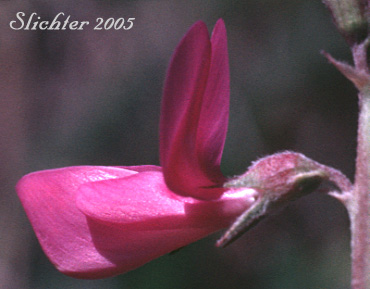
Synonyms: Hedysarum boreale ssp. mackenzii, Hedysarum mackenzii

 The
photo at right shows the congested raceme of northern hedysarum (variety mackenzii)
as seen along the Hurricane Creek Trail in the Eagle Cap Wilderness of northeastern
Oregon........June 26, 2004.
The
photo at right shows the congested raceme of northern hedysarum (variety mackenzii)
as seen along the Hurricane Creek Trail in the Eagle Cap Wilderness of northeastern
Oregon........June 26, 2004.
Northern hedysarum is an attractive, herbaceous perennial wildflower with clustered stems atop a wood taproot, the stems simple to branched depending upon the variety and arising from 20-60 cm high. The compound pinnate leaves are 5-15 cm long with 7-15 leaflets, elliptic-oblong in outline and measuring 10-25 mm long. The upper surface of the leaflets range from glabrous in variety mackenzii to covered with short, stiff, appressed gray hairs on both surfaces on variety boreale.
The flower stems are 10-25 cm long and the racemes are held above the upper leaves. The racemes are 5-50 flowered and are short in variety mackenzii or elongated in variety boreale. The flowers are held erect or are spreading and measure from 11-22 mm long. The linear-lanceolate calyx teeth are generally longer than the bell-shaped calyx tube. The keel is the longest petal and is obtuse in shape. The wings are shorter than the keel or banner and are much narrower than the keel. 10 stamens are present, with 9 joined together and the tenth free. The style is curved. The pendant pods consist of 2-8 rounded segments, each about 6 mm in diameter with narrow margins.
variety boreale: Racemes elongating up to 15 cm long with 12-20 carmine, magenta or purple flowers, each measuring from 11-17 mm long. Plants generally branched and with more grayish, short, stiff and appressed hairs than the next variety. The ventral leaflet surface is only faintly veined. Pods with 2-6 segments. Found from British Columbia east to Alberta and south through Idaho, Montana and South Dakota to Arizona and New Mexico. Also found in the Wallowa Mts. of northeastern Oregon.
variety mackenzii: Racemes compact, 2- 6 cm long with 5-15 purple flowers, each measuring from 18-20 mm long. Plants generally unbranched and greenish, the upper leaf surfaces glabrous or with some short, stiff, appressed hairs. The ventral surface of the leaflets are conspicuously veined. Pods with 3-8 segments. Found from the Yukon east to Newfoundland and south to southern British Columbia and east to Alberta and Manitoba. Evidently this variety is also found in the Wallowa Mts. of northeastern Oregon.
In the Wallowa Mts, northern hedysarum may be found in gravelly riparian areas , on rock slides or on dry wooded slopes growing amongst shrubs between the elevations of 5000-8000 feet.
Variety mackenzii may be found from the Yukon east to Newfoundland and south to southern British Columbia and east to Alberta and Manitoba. Evidently this variety is also found in the Wallowa Mts. of northeastern Oregon.